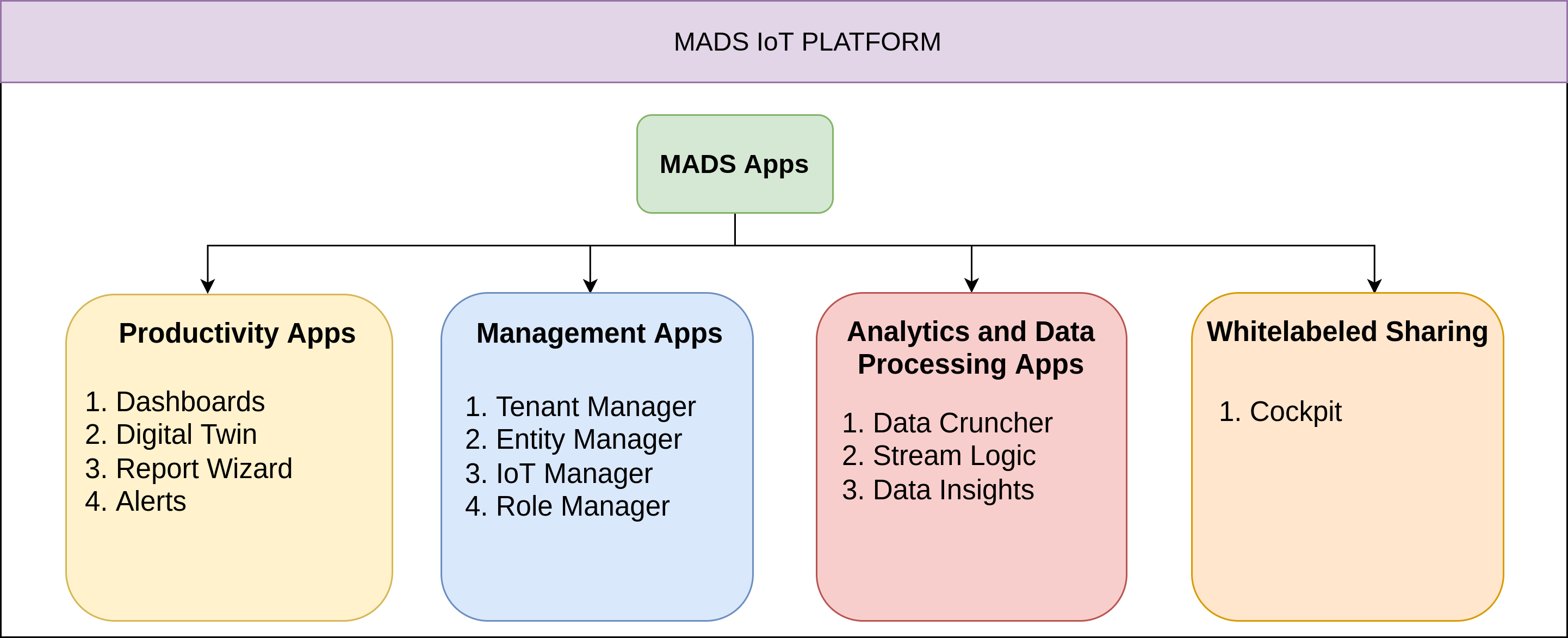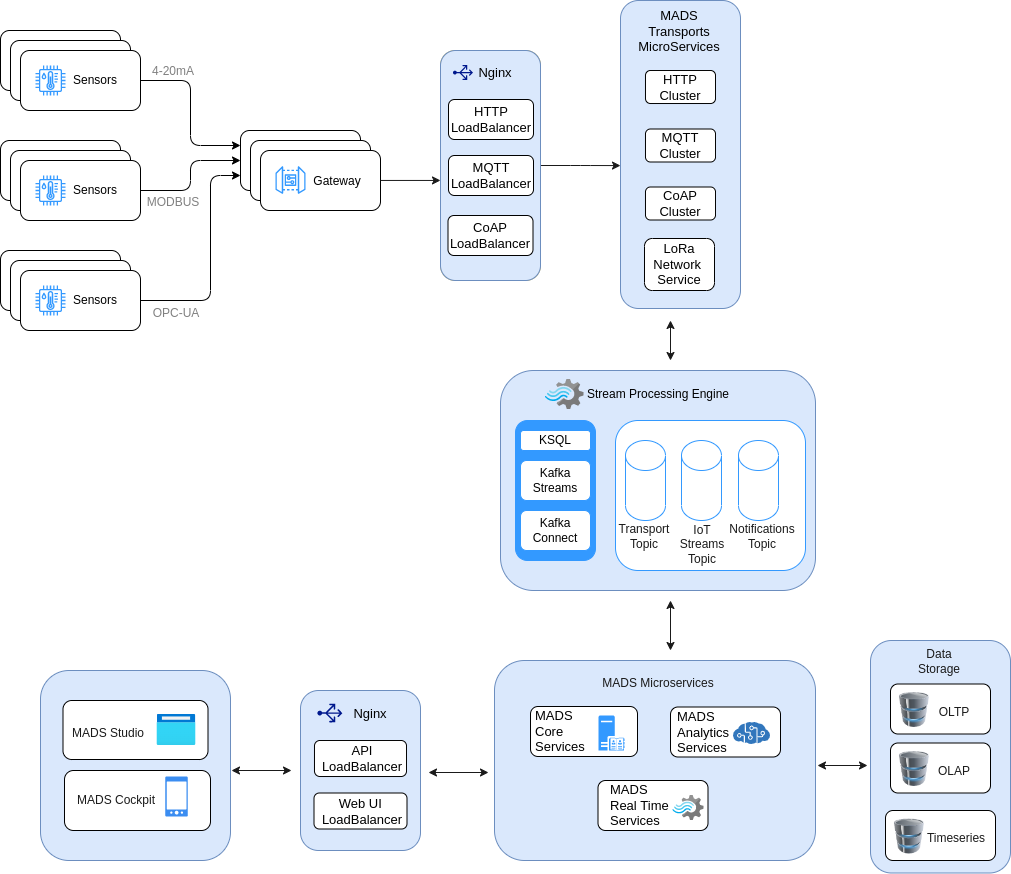Fast, flexible, and user-friendly, MADS is the leading platform for building IIOT solutions.
What is MADS?
MADS is a 100% self-service no-code intuitive IoT platform for rapid implementation of enterprise IoT projects. It enables quick development, management, and scaling of IoT use-cases. Any enterprise IoT project has some desired outcome to realize the the ROI of the project. The desired outcome is what the stakeholders are interested in, however to realize that outcome there are certain foundational steps:
- Create a design of the IoT project
- Connect and collect all the IoT data
- Define data pipelines and apply the business logic
- Analyze and visualize the generated information from raw data.
- Take action to complete the feedback loop.
The above steps are fundamental to deployment of any IoT project. Conventionally these steps were developed as applications and tools by software developers in collaboration with domain experts who understood the usecase. However, since these steps are common an abstraction layer can be created to stop reinventing the wheel and create a horizontal IoT platform which comes with such features baked in. This kind of support allows the domain experts to use the platform to build the usecase on their own and rapidly customize and deploy it for their users.
MADS platform took a novel approach of managing the details of the above mentioned steps using the concept of apps. MADS apps can securely combine data visualization with advanced analytics to provide easy-to-understand insights and actionable maintenance recommendations. It can be used to manage building and asset health, to enable you to make informed reliability decisions and optimize your operations. MADS collects, stores, and transports data using secure cryptography, resilient even to quantum attacks.
The below tree explains different types of apps in the MADS platform.

Architecture
MADS has been designed to be:
Fault tolerant: The system is designed to keep running when some unforeseen bugs
creep in, network connection drops, or the machine running the system crashes.
In case of such an event, the system falls back to redundant servers.
Scalable: The platform is capable of ingesting millons of data points to crate
powerful analytics. With horizontal scalability baked in it’s able to adjust to
incoming traffic and scales.
Distributed: The platform is built as a loose coupling of multiple microservices
working together to support differrent use cases.
Responsive: The platform is cotinoulsy updated to provide a fast response time
for users with p99 < 100ms using autoscaling based on advanced algorithms to
predict user traffic and self-adjust.
Secure: It uses latest cryptographic constructs to manage credentials. Data
encryption is performed rest and motion for all transports with TLS1.2 and hybrid
classical & post-quantum encryption
The below diagram shows the key components of the MADS platform

MADS Transport Services
Transport microservices deals with providing a mechanism for IoT gateways to send data to the cloud.
The supported transports in MADS are:
HTTP: HTTP(S) is a general-purpose network protocol that can be used in IoT applications
for exchanging data. Details can be checked here. The HTTP service is written in Elixir
lang with support of Phoenix library and secured with TLS.
MQTT: MQTT is a light-weight publish-subscribe protocol making it ideal for IoT
gateways. The MQTT service is written in Elixir lang and the broker used for MQTT is
Vernemq. The base security layer is over TLS.
CoAP: CoAP is a light-weight IoT protocol for constrained devices. CoAP protocol
is UDP based, but similar to HTTP, it uses a request-response model. CoAP observes
option allows to subscribe to resources and receive notifications on resource change.
The CoAP service is written in Elixir lang.
LoRaWAN: LoRaWAN is a media access control (MAC) protocol for wide area networks.
It is designed to allow low-powered devices to communicate with Internet-connected
applications over long-range wireless connections. LoRaWAN can be mapped to the
second and third layer of the OSI model. It is implemented on top of LoRa or FSK
modulation in industrial, scientific and medical (ISM) radio bands.
The underlying stack used for creating the microservices HTTP, MQTT and CoAP is Elixir/OTP. The LoraWAN service is based on a service from chirpstack to manage LoRa devices, Chirpstack provides a network and application server which are stable and battle-tested.
MADS Microservices
MADS services cater to different business requirements in the domain of IoT. The services are modeled around business domains to provide a list of features, this is also referred to as a bounded context in DDD, domain-driven design.
MADS takes a hybrid approach to map apps to microservices. Certain apps which have similar requirement in terms of infrastructure(hardware), domain and dependencies are grouped together in a single microservice.
At present there are 3 different microservices:
MADS Core Services
MADS core services are responsbile for administration, multi-tenancy and visualisatons. Apps such as Role Manager, Entity Manager, Dashboards, Reports, Digital Twin are part of this service. The service uses a mix of Elixir and Nodejs stacks for building these domains.
MADS Real-time Services
MADS Real-time services are responsible for dealing with huge amount of IoT data being pushed from various sources. Apps such as IoT Manager, Streams, and Alerts and Notifications are grouped under this category. This service manages all the devices as well as services connecting to MADS and pushing data. All the device related alerts are also managed via these services. Control signals which emerge from MADS are also pushed to the device via these services.
MADS Analytics Services
MADS Analytics services take care of all the statistical as well as Machine learning based analysis. Apps such as Data Cruncher, Data Insights and AI studio are grouped under these services. The underlying layers involve big data and batch processing tools such as spark, airflow to orchestrate and run jobs and generate information which is placed in the data warehouse to be read by visualisation and reporting apps. The stack utilized is a mix of python and elixir to achieve the required outcome.
Data Storage
IoT work loads are very data heavy, once your IoT challenges are over your big data challenge starts in the IoT world. Since there is no single database which can cater to all these challenges MADS uses a hybrid data storage model for different type of workloads.
OLTP
Most of the administration related work in MADS as well as complex relations among different entities are maintained in an OLTP database, this is also the storage layer where all the interactions with users happens the most. For this layer we use Postgres as the database. Using an SQL database allows us to maintain strong transcational guarantees which are essential for OLTP workloads we get on MADS.
TimeSeries Database
There is a tremendous amount of data being generated by sensors in the IoT world, > 90% of this data is timeseries data coming from various assets being monitored. In order to deal with this huge volume in real time, we required a database which can ingest timeseries data in real time, is distributed so we can scale as the volume increases, and can perfrom basic aggregations for real time visualisations. To meet all these requirements we chose CrateDB.
OLAP Database
Analytics is bread and butter of any IoT solution, it’s the final outcome which the stakeholders depend on for the decision making process. The very need for collecting a huge amount of data from the sensors is to apply business rules store the data and then perform queries against it to draw valuable insights from it. In the IoT world the demand for analytics is also on the sub-second level which makes it quite challenging. In order to meet these requirements we use Apache Druid a highly optimized database for meeting subsecond ad-hoc queries with high concurrency requirement.
Deployment
MADS services are deployed as containerized applications. Containers are the best way to bundle and deploy applications. They provide a platform and premise independent way of doing deployments. Also, using containers allows for easy continuous integration and continuous deployments (CI/CD).
The lightweight nature of containers also allows easy managing which will ensure that there is minimum to zero downtime. The containers are managed using a container orchestration servcie.
The MADS platform leverages Kubernetes as an enterprise-grade orchestrator platform for all the solutions. It lets you abstract from managing containers lifecycle, mitigation of node failures, networking, and much more, keeping the focus on the business domain only.